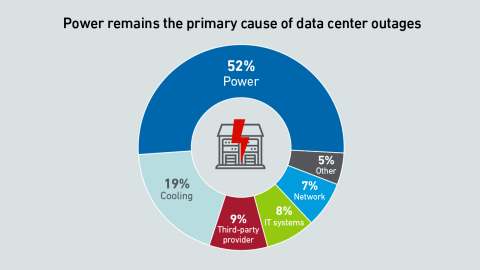Adoption of direct liquid cooling (DLC) continues to grow slowly, according to recent Uptime research. However, more operators are considering it for future use due to mounting thermal management and sustainability challenges.
filters
Explore All Topics
This report looks at the leading frameworks for carbon reporting with regards to energy attribute certificates (EACs) and Scope 3, including their sector-specific guidance (if any) for data centers.
Results from the Uptime Institute Supply Chain Survey 2023 reveal that data center owners and operators are continuing to suffer supply chain delays, but these appear to be less frequent and severe than in 2022.
Electric grids face serious issues largely because of national efforts to reduce carbon emissions and boost electrification. Data center growth will add to these problems - but unreliable data could lead to poor decision-making.
Identifying the extent of security requirements is a critical first step in building a viable data center cybersecurity strategy. Data center managers should identify and answer essential questions to implement an effective playbook.
The reporting of IT equipment Scope 1 to 3 emissions across the data center value chain can account for the same emissions up to six times. Sustainability efforts should favor achieving more efficient, less carbon-intensive operations.
Most cyberattacks are sudden and target financial gain. Attacks on data centers and critical infrastructure can be very different. State-sponsored hackers use varied and sophisticated tactics in support of geopolitical goals.
This report captures some findings from the Uptime Institute Sustainability and Climate Change Survey 2023, including that more than half of operators are still to set a net-zero emissions goal and less than half compile key metrics.
Cyberattacks on operational technology (OT) systems are rising, and OT failure could be catastrophic for data centers. Managers need to understand the nature of the threat and the defense options to protect their critical environments.
Uptime Intelligence is inviting interested parties to collaborate on an initiative to improve data sharing between co-hosting / colocation companies and IT operators in order to comply with regulations and meet sustainability goals.
Refrigeration's history of progress is also a history of environmental concern. Whenever new refrigerants solve a problem, they create further crises down the line - and now history appears to be repeating itself.
Uptime Institute draws lessons from global outages data for 2024's annual benchmark review of the impacts, costs and changing types and frequency of crucial infrastructure failures.
The final EED delegated regulation was published on March 14, 2024. Data center operators have until September 15, 2024, to report the required information and key performance indicators to the EU database on data centres.
Avoiding digital infrastructure failures remains paramount for data center owners and operators. This report analyzes recent Uptime Institute data on IT and data center outage trends: their causes, costs and consequences.
The 2024 Uptime Institute Cooling Systems Survey (n=964) explores the adoption, usage, and benefits of various cooling systems in the data center. The attached data files below provide full results of the survey, including data cuts based on…
 Douglas Donnellan
Douglas Donnellan

 Dr. Tomas Rahkonen
Dr. Tomas Rahkonen

 Rose Weinschenk
Rose Weinschenk

 Peter Judge
Peter Judge

 Michael O'Neil
Michael O'Neil
 Antonio Ramos
Antonio Ramos

 Jay Dietrich
Jay Dietrich




 Andy Lawrence
Andy Lawrence

 Daniel Bizo
Daniel Bizo
 Jacqueline Davis
Jacqueline Davis
 Rosa Lawrence
Rosa Lawrence

 Chris Brown
Chris Brown



 Anthony Sbarra
Anthony Sbarra
 Laurie Williams
Laurie Williams
